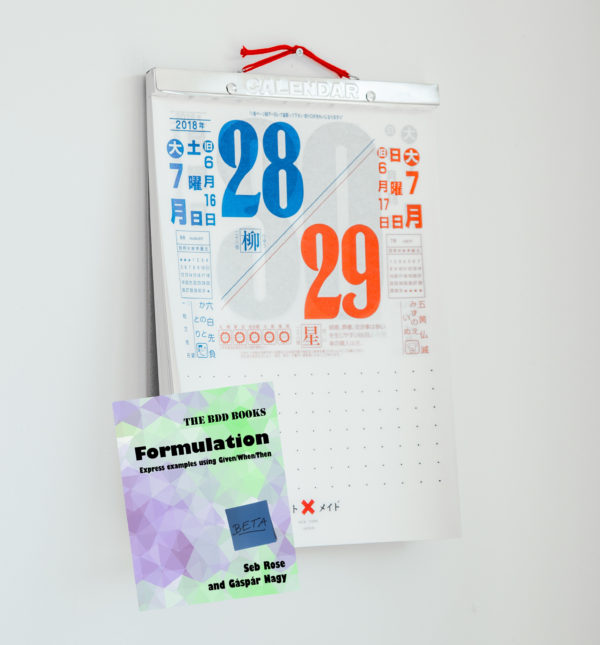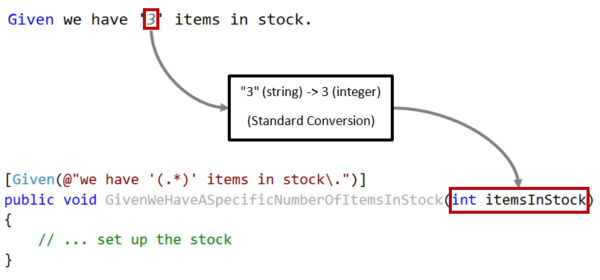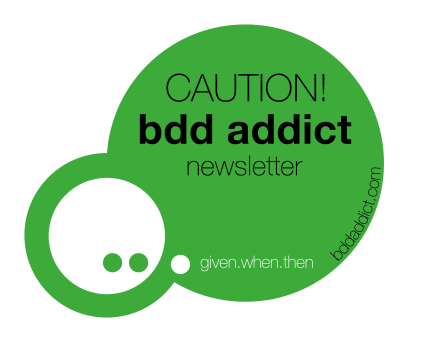The monthly dose for BDD addicts… In March stories by Amir Ghahrai, Ron Jeffries, Gaspar Nagy, Paul Rohorzka, Liraz Shay and Mark Winteringham…
Subscribe to the monthly newsletter at http://bddaddict.com so that you never miss it! (Did you get the February issue?)
Dear BDD Addicts,
February is the shortest month and for a long time it was the last month of the year. This explains why some months have a number-reference in their name (like October – octo – 8) that refer to a wrong index! As a bdd addict, this should remind you to express the intention and not the mechanics (solution details, indices), regardless whether you need to give a name to a month or write a readable scenario. This is also what I was talking about at my courses this month and this is what we emphasize in the Formulation book whose first chapters we have just released.
How was February for you? Would you share it with other addicts? Please send me the link with some comments to bddaddict@specsolutions.eu.
But now, let’s dive into our monthly dose…

[BDD] If I could do my BDD setup again
Historians typically disregard discussions starting with “what if” questions as they are too speculative. Certainly they are, however, these questions sometimes help better understanding why things happened the way they did (see Counterfactual history for more on this). In the following article we can better understand how to get a better BDD setup through the experience that Mark Winteringham had and what he would have done differently today.
Using Cucumber in split discipline teams (Mark Winteringham, @2bittester)

[Agile] Drag yourself out of the Dark Scrum with BDD
| The name Ron Jeffries might sound familiar to many agile practitioners, as he is one of the three founders of XP and one of the signatories of the Agile Manifesto. In this post, he is talking about the dark scrum. The kind of scrum (or general agile process) that probably we all know well: when we try to play scrum ceremonies but somehow things don’t get better. He also has a set of good suggestions as well that can drag us out from this darkness. While the term BDD is not listed explicitly, we all can read between the lines… |
Dark Scrum (Ron Jeffries, @RonJeffries)

[VIDEO/BDD] Why BDD?
This one is my story. At conferences and courses we usually talk a lot about the real benefits of BDD. In the Discovery book, we also focused on this aspect and listed many contexts and situations where BDD can help. In this recorded webinar, I am talking about three key benefits that we have observed on the first projects where we introduced BDD. (Thanks to Hiptest for organizing the webinar.)
Is BDD for Me? (Gaspar Nagy, @gasparnagy)

[Automation] Automated holidays
What is a difference between staying at a nice place for a couple of days or watching a NatGeo film about it? You will probably enjoy the film, but being there is completely different. Because you are there, you can talk to people, stop where you want and get deeper into what you are interested in. The difference is you. Amir Ghahrai thinks about User Journeys in a similar way: the users’ emotions are an important part of it. However, in automated user journey tests these emotions are mostly ignored… Should we automate them then?
Can You Really Automate a User Journey? (Amir Ghahrai, linkedin:aghahrai)

[BDD] Write better feature files
Scenarios and feature files have got a central position in BDD. A good feature file is typically a result of a good collaboration and it is the source of an effective automated test. Liraz Shay has compiled a good list of important things to watch for so I am happy to share it with other bdd addicts.
BDD Cucumber Features Best Practices (Liraz Shay, linkedin:lirazshay)

[BDD/SpecFlow] Express your domain concepts using step argument transformations
We would like to keep our scenarios (business) readable, but we also have to make them easy(er) to automate. This dilemma also comes up when we would like to express different domain concepts in a way the business expresses them. Do they say “6pm” or “18:00”? “No items” or “0 items”.
In many Cucumber implementations, there is a way to extend the parameter conversion system of the tool. In SpecFlow, this can be done using the step argument transformations as explained in detail by Paul Rohorzka.
Improving Gherkin Specs with SpecFlow Step Argument Transformations (Paul Rohorzka, @paulroho)




